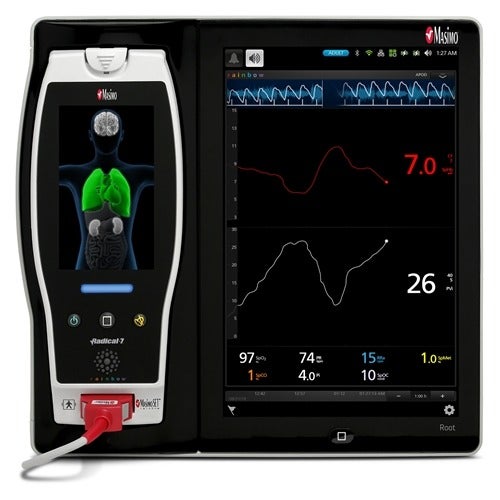
Masimo announced today that in a study recently published in Anesthesia & Analgesia, researchers evaluated the ability of noninvasive and continuous hemoglobin monitoring with Masimo SpHb to detect the development of acute hemodilution after graded fluid administration, by comparing it to invasively measured laboratory hemoglobin (BHb), on patients undergoing major surgery.
In the study, Dr. ŞerbanBubenek-Turconi and colleagues at the Carol Davila University of Medicine and Pharmacy and the Prof. C.C. Iliescu Institute for Cardiovascular Diseases in Bucharest, Romania, and Sheba Medical Center in Tel Aviv, Israel, examined the effects of incremental fluid loading (as part of perioperative goal-directed therapy (GDT)) on oxygen delivery and whether noninvasive SpHb monitoring could reliably track the development of acute hemodilution (which can necessitate blood transfusions that might otherwise be avoided). They analyzed data from 40 adult patients undergoing major gastrointestinal or vascular surgery. SpHb was continuously measured using Masimo Root with the Radical-7 Pulse CO-Oximeter. BHb and partial pressure of oxygen (PaO2) were intermittently, invasively measured using a Radiometer ABL800 blood gas analyzer. Cardiac output (CO) and stroke volume (SV) were also obtained through invasive modalities. Oxygen delivery (DO2) was calculated as: CO*((Hb*1.38*SpO2)+PaO2*0.0031)). Parameter values were recorded after the induction of general anesthesia and before the start of surgery (T0) and 5 minutes after successive 250 ml colloid fluid challenges (FC) (T1, T2, and T3). Patients were given the second and third fluid challenges if at each stage SV increased by at least 10%. 40 patients received the first FC, 32 received the second, and 20 received the third, for a total of 92 administered FCs.
The researchers found that, “Compared to their baseline values (T0), BHb and SpHb decreased by a mean of 5.3% ± 4.9% and 4.4% ± 5.2%, respectively, after the first FC (T1; n = 40), by 9.7% ± 8.4% and 7.9% ± 6.9% after the second FC (T2; n = 32), and by 14.5% ± 6.2% and 14.6% ± 5.7% after the third FC (T3; n = 20).” Using Bland-Altman analysis of all 132 paired SpHb and BHb values, the researchers found mean bias and precision values of -0.3 ± 1.5 g/dL and limits of agreement of -2.7 to 3.3 g/dL. They also found that concordance rates between changes in SpHb and in BHb after the administration of the 250, 500, and 750 mL of fluid were 83%, 90%, and 100%, respectively. They noted that results showed “excellent” concordance after 750 mL, despite the limited absolute accuracy, which may have been negatively affected by the “well-recognized inherent variability of the laboratory Hb device that served as our reference method.”
The researchers concluded, “In summary, our study shows that acute iatrogenic hemodilution does invariably occur after fluid administration, that it may lead to paradoxical decrease in DO2 especially in ‘nonresponders’ and that its development is made visible by the continuous monitoring of SpHb when >500 mL of colloids are being administered. Further studies are needed to examine the potential clinical benefit of SpHb monitoring in identifying acute hemodilution.”
SpHb is not intended to replace laboratory blood testing. Clinical decisions regarding red blood cell transfusions should be based on the clinician’s judgment considering among other factors: patient condition, continuous SpHb monitoring, and laboratory diagnostic tests using blood samples.
Source: Company Press Release






